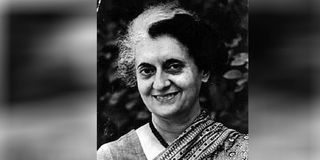Make policy, science, farmers cradle of a green revolution

Former Indian Prime Minister Indira Gandhi.
Jai Jawan, Jai Kisan (Hail the Soldier, Hail the Farmer)!” Indians shouted in joy and appreciation of the leadership of Indira Gandhi’s green revolution in agriculture and their war with Pakistan. This is 1966, during the reign of the greatest Indian woman leader, who had to navigate a spate of food emergencies that created a tight supply chain.
An average of three ships a day carrying grains and food supplies from the US would dock under President Dwight D. Eisenhower’s American Food for Peace Programme. The food was immediately distributed and consumed, reducing the newly independent India to a ship-to-mouth economy.
Today, India is considered food-secure. Much the credit for that goes to Prime Minister Gandhi and her close association with her American counterpart, President Lyndon Johnson. But that did not come without opposition, with the president of the Congress, Kumaraswami Kamaraj, chastising Delhi by painting reliance on external aid as humiliating.
Democracy
The inflection point for the then-fledgling democracy came when, it is said, Mrs Gandhi, in a call to Johnson to request him to release the shipment, clenched her fingers around the telephone receiver.
When she hung up, she told her press adviser, Sharada Prasad: “I don’t ever want us to have to beg for food again.” And that was the birth of the biggest green revolution that, in a year, converted India from a begging bowl to a bread basket. India did not rely on Western help only but, even amid Cold War, it supplemented it with Soviet technology.
US scientists and advisory teams landed in India, levelled land and trained Indian scientists and PhD students. There was deep cooperation between American and Indian universities and, through it, India received its first shipment of life-saving seed drives in 1966.
Despite the drought, Gandhi’s Food and Agriculture Minister Chidambaram Subramaniam became a super minister with a direct connection with President Johnson and US scientist Norman Borlaug, a future Nobel Peace Prize winner who had developed a high-yield, disease-resistant variety of wheat. Funded by the Rockefeller Foundation, Borlaug had been introduced the wheat variant in Mexico, where it found tremendous success.
War front
Kenya faces a prolonged drought, just like the 1966 India. A war front far away from our borders (Ukraine) is affecting our food security. Energy prices have skyrocketed, making mechanised agriculture unsustainable and our industry products expensive. Is Kenya ripe for a green revolution?
Me say yes. For one, the much-maligned genetically modified organisms (GMO) might just be the magic seeds for our green revolution, coupled with fertiliser subsidy and planned massive water harvesting by constructing 1,000 dams. But Kenya should not just take GMO but finance and incentivise institutions, researchers and PhD students, to achieve maximum technology transfer from the West and East.
Amid climate change, smallholder farmers should have clear line benefits from climate-smart technology such as solar pumps and driers for post-harvest food preservation. Termed the Indian feat a “Symphony Orchestra” , Chidambaram cited three cradles of the revolution: Policy, science and farmers.
Ms Hassan is the business development manager at Solarnow (K) Ltd. [email protected].





